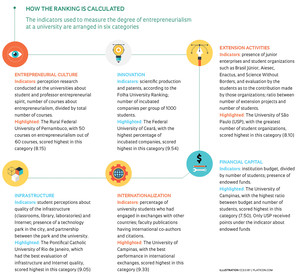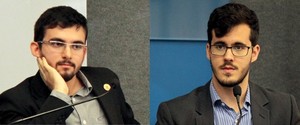 On November 10, 2016 in Brasília, a group of student organizations announced a ranking of 42 Brazilian universities that have been particularly successful in encouraging innovation and an entrepreneurial spirit, when measured by a set of 14 indicators. The 2016 Index of Entrepreneurial Universities exhibits, at the top two positions, universities that have already won recognition in several academic rankings: the University of São Paulo (USP) and the University of Campinas (Unicamp). Although the names of the leaders came as no surprise, the ranking is innovative in that it identifies the efforts by institutions in several different states, such as the Federal University of Ceará (UFC) and the State University of Maringá (UEM) in Paraná, in building an entrepreneurial environment.
On November 10, 2016 in Brasília, a group of student organizations announced a ranking of 42 Brazilian universities that have been particularly successful in encouraging innovation and an entrepreneurial spirit, when measured by a set of 14 indicators. The 2016 Index of Entrepreneurial Universities exhibits, at the top two positions, universities that have already won recognition in several academic rankings: the University of São Paulo (USP) and the University of Campinas (Unicamp). Although the names of the leaders came as no surprise, the ranking is innovative in that it identifies the efforts by institutions in several different states, such as the Federal University of Ceará (UFC) and the State University of Maringá (UEM) in Paraná, in building an entrepreneurial environment.
The new ranking is available at bit.do/brasiljunior. “Besides teaching and doing research, a university should promote working with companies and encourage students and professors to innovate and generate wealth,” says Daniel Pimentel Neves, 24, one of the index coordinators. He is currently director of ecosystem impact at Brasil Júnior, a confederation of junior enterprises affiliated with universities in Brazil. Holder of a law degree from the Federal University of Juiz de Fora (Minas Gerais) he was the founder of Colucci, a junior enterprise that offers legal consulting services. Like all companies of its kind, it provides services to clients and reinvests its earnings in company business.
The ranking prepared by the students attracted attention because of its format and the speed with which it was constructed. Planning, gathering and analyzing the data took only six months. Construction of the index involved the efforts of young volunteers affiliated with associations like Brasil Júnior and the Rede CsF, a network that brings together grantees and former grantees from the Science Without Borders international exchange program established by the federal government. Also participating in the initiative were two international student organizations, Aiesec and Enactus, devoted to activities in exchanges, extension courses, and entrepreneurialism, as well as Brasa, an association of Brazilian students who are living outside Brazil. These partnerships selected the case studies that illustrate the book in which the index was published.
“We used our ability to develop connections to expedite the process. On several different occasions, we were able in just a few hours to mobilize students in every corner of Brazil to gather data and apply research,” says Guilherme Rosso, 22, co-founder of Rede CsF. Recently graduated in sciences and technology from the Federal University of Rio Grande do Norte, Rosso is currently pursuing his master’s degree at USP’s School of Arts, Sciences and Humanities. The idea to create an index came up early in 2016, after the leadership of Brasil Júnior had performed an evaluation of a program devoted to disseminating entrepreneurial spirit in universities and concluded that the results were below expectations. “That program, Entrepreneurial Schools, has in the past three years sponsored more than 80 events about entrepreneurialism at universities in Brazil. But despite attracting a satisfactory attendance at those events, they did not help transform the academic environment the way we were expecting,” says Daniel Pimentel. “The idea of an index was a natural one because rankings mobilize universities and encourage them to compete and improve.”
 This coordination with other entities repeated the strategy adopted between 2014 and 2015, when the same organizations worked together to win approval by Brazil’s Congress of the Junior Enterprise Act, which passed in April 2016. “All the organizations had promised to collaborate, but there was one serious problem: none of us knew how to produce a ranking,” Russo recalls. In order to achieve methodological consistency, the students requested the help of an expert, the McKinsey consulting company and researcher Guilherme Ary Plonski, who is a professor at both the USP Polytechnic School and the USP School of Economics, Business Administration and Accounting. Justin Axel-Berg, an Englishman who had settled in Brazil and had studied rankings of universities, also joined the group and made suggestions about methodology.
This coordination with other entities repeated the strategy adopted between 2014 and 2015, when the same organizations worked together to win approval by Brazil’s Congress of the Junior Enterprise Act, which passed in April 2016. “All the organizations had promised to collaborate, but there was one serious problem: none of us knew how to produce a ranking,” Russo recalls. In order to achieve methodological consistency, the students requested the help of an expert, the McKinsey consulting company and researcher Guilherme Ary Plonski, who is a professor at both the USP Polytechnic School and the USP School of Economics, Business Administration and Accounting. Justin Axel-Berg, an Englishman who had settled in Brazil and had studied rankings of universities, also joined the group and made suggestions about methodology.
The group met In May 2016 to plan the ranking. The first step was to conduct an online survey of students and professors from different universities in Brazil in order to find out what features are typical of a university that has an entrepreneurial profile. “The students who were responsible for the ranking themselves exhibited entrepreneurial behavior when looking for answers to questions: at the end of the day, what is an entrepreneurial university and where in Brazil are they to be found?” Plonski recalls. Based on 4,700 responses, four characteristics emerged on which there was consensus: a prevailing entrepreneurial culture between professors and students; extension activities in entrepreneurialism; intensity of innovation, measured by number of patents; presence of company incubators and scientific production; and the physical infrastructure itself, translated into establishment of technology parks and the availability of good Internet networks. Each of these factors was converted to a category in the index, to be evaluated by using indicators and/or survey study results.
Two more categories were added, although not deemed relevant by all respondents. One is the degree of internationalization of the university, assessed by the number of student exchanges and publications by teaching staff that were co-authored with researchers from other countries. “The internationalization factor appeared significant only among those respondents who had lived for a time in other countries. We decided to include that category because it had become clear that international experience gives young people a more entrepreneurial mindset,” says Rosso. Financial capital was included at the suggestion of experts, in light of evidence that the size of a university’s budget and the existence of endowments are important in spurring innovation at these institutions.

Leonor Calasans/IEA/USP
Guilherme Russo (at left) and Daniel Pimentel Neves coordinated data collection and production of the indexLeonor Calasans/IEA/USPThe next step was to choose indicators. In some cases, data on each institution was collected by about 80 “ambassadors,” students affiliated with the organizations that constructed the index. This was the case, for example, for the number of subjects in the institution’s curriculum about entrepreneurship, and the presence of incubators and technology parks in the vicinity of the university. In other cases, data collected by the Folha University Ranking (RUF) organized by the newspaper Folha de S.Paulo, was used to indicate scientific production and patents.
The ambassadors conducted opinion surveys with more than 6,000 students and professors at the 42 selected institutions. The results served as a basis for various categories in the ranking. This was the case of the scoring of the entrepreneurial spirit of students and professors. Students self-evaluated when responding to the survey and also evaluated the faculty—and the results of those perceptions were recorded in the index.
Some categories yielded surprising results. On the question of Entrepreneurial Culture, the Rural Federal University of Pernambuco (UFRPE) won first place because of a concentration of subject matter about entrepreneurialism—there were 50 in a 60-subject curriculum, while the UFC scored highest in the category Innovation, thanks to a high concentration of incubated companies. PUC/Rio led in Infrastructure, because it is associated with a technology park and received the highest score in the survey of perception about the quality of the physical infrastructure and Internet speed.
 The high percentage of students involved in international exchanges placed Unicamp at the top in Internationalization. That institution also ranked first in Financial Capital because it exhibits the best ratio between budget and number of students. USP also performed well on that question because it is the only university on the list that has an endowment fund – the Friends of Poli (see Pesquisa FAPESP Issue nº 219). USP was also first in Extension, thanks to the presence on its various campuses of several student organizations associated with entrepreneurialism.
The high percentage of students involved in international exchanges placed Unicamp at the top in Internationalization. That institution also ranked first in Financial Capital because it exhibits the best ratio between budget and number of students. USP also performed well on that question because it is the only university on the list that has an endowment fund – the Friends of Poli (see Pesquisa FAPESP Issue nº 219). USP was also first in Extension, thanks to the presence on its various campuses of several student organizations associated with entrepreneurialism.
An unexpected recognition of the efforts by students came from Henry Etzkowitz, an American and a professor at Stanford University. He was one of the formulators in the 1990s of the innovation model known as the Triple Helix concept of university-industry-government relationships. He is now working on an initiative that involves several countries, including Brazil, which is trying to develop global metrics for assessing entrepreneurial universities. Etzkowitz signed the preface of the book that presents the results of the index, writing: “New metrics are necessary to supplement the existing ones and recognize the emerging role of the university in promoting socioeconomic development.” Etzkowitz was visiting Brazil in November 2016 and took part in discussions at which the ranking was presented in São Paulo and Rio de Janeiro. “Not only did he honor us with his presence, but later we all went out to a bar in Ipanema and found him to be excellent company,” Rosso says.
There are plans to produce a new edition of the index within one or two years. “The idea is to create more sophisticated indicators, request more data from the universities, and include new categories for the perception surveys,” suggests Neves. One idea, he says, would be to examine the entire curriculum grid of the courses in order to find out to what extent the contents and forms of evaluation encourage an entrepreneurial spirit among the students, instead of merely counting the number of courses on entrepreneurialism. Both Neves and Rosso will be available to guide the production of the index, but since they are leaving university and entering the job market, they will probably be replaced by younger students. “Turnover is not a problem for our movement, which gains strength even while it renews itself,” says Neves.
Republish
